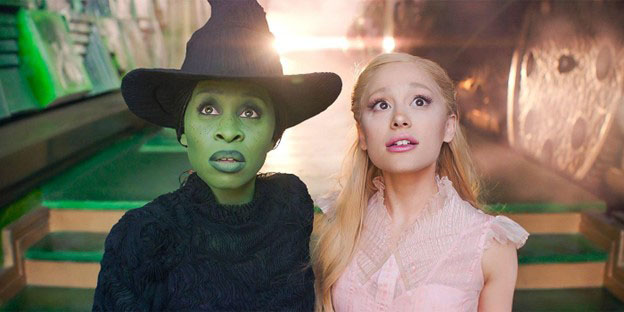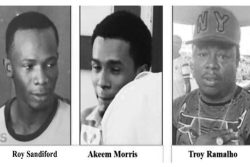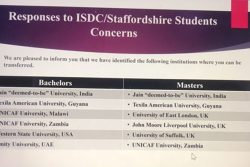It has been a long road to the screen for the musical. Its direct ancestor had its opening night on Halloween in 2003. This new film adapts Act One of the two-act play. But, before that, “Wicked” was a novel, an adult-revisionist novel subtitled “The Life and Times of the Wicked Witch of the West”, which was a descendent of Frank Baum’s children’s novel “The Wonderful Wizard of Oz”. On film, though, no filmic entry is as sharp a prelude to Chu’s film as the 1939 blockbuster “The Wizard of Oz”. Since entering the canon, Victor Fleming’s musical film has endured as one of the seismic examples of fantasy cinema and musical cinema. Whatever its iteration, the story of Oz – a magical, colourful land where animals talk, and witches fly is marked by its imaginative power. There’s a reason so many various versions of it have endured for more than a century. There are enough things to charm in “Wicked: Part 1” that make it a pleasant entry in the annals of Oz, but one striking sensation is that this “Wicked” never feels as meaningful in any way. For all its effort, there is never a moment in it that imagines anything from any of its source materials in any way that’s more charged, or whimsical, or daring, or spectacular than its predecessors. This is a world of magic, and yet “Wicked” often feels only mutedly imaginative.
“Let me tell you the whole story…” We hear Ariana Grande as Glinda the Good Witch say these words before we see her arrive in pink splendour early in John Chu’s recently released adaptation of “Wicked”. It’s a basic claim that the film does not actually honour, even though that inability runs through the way the film develops structurally and artistically. Glinda’s words are to us, as well as to the Ozians. The entire conceit of the musical, like the play and book that came before it, is its commitment to refuting the legacy of witches in the original Oz-tales. In “Wicked”, the Wicked Witch of the West is reimagined as Elphaba, an audacious and talented student whose passion for social justice leads to her being villainised by the Wizard of Oz and unfairly targeted as a monster. Recent fantasy-films have enjoyed looking at the untold stories of villains. Disney notably popularised it with Angelina Jolie in her “Maleficent” films and the trend has maintained with hits like Emma Stone in “Cruella”. “Wicked” fits right into this mode for good, and for bad. In a dismal echoing of Hollywood’s financial greed and a constant inclination towards sequels, the single story of “Wicked” has been split into two. A two-act with a single straightforward story has been imagined as two.
If taken in good faith, the choice to split the play into two stories might be imagined as a sign of daring from the creators of the film. Chu is coming off fresh work on the movie musical “In the Heights”, a warm and exuberant adaptation of another Broadway play that was sadly undervalued upon its release. The writers of the play, librettist/screenwriter Winnie Holzman and musician Stephen Schwartz have returned to the film, suggesting a canny opportunity for the creators to look at their old work with new eyes. Faced with an opportunity to turn a single tale into two, the potential skill of this trio to do something ambitious with the story of a woman villainised by an opportunist and leading a society astray is surely relevant. But from the first 20 minutes of the film it becomes evident that “Wicked” is unable to argue any meaningful dramaturgical reasons for dividing the play into two films. Instead, the first act is merely stretched to accommodate a 150-minute running-time that still leaves aspects of the plot with gaps. After the citizens of Munchkinland celebrate the death of the Wicked Witch, Glinda takes us back to when she first met the Witch as schoolmates at university. The opening sets up the (half) film to come.
When the governor of Oz sends his younger daughter Nessarose to Shiz University, he insists on having her older sister Elphaba remain with her for protection. Nessarose needs a wheelchair for mobility, and while the governor abhors Elphaba and her green skin he needs her help in protecting Nessa, his favourite. Elphaba reveals an untrained propensity for magic and catches the eye of the Shiz Sorceress Madame Morrible (Michelle Yeoh). She also catches the resentment and then friendship of Glinda. The full story of “Wicked” is not quite a prequel or sequel to “The Wizard of Oz”. The major climaxes of its story happen while Dorothy’s journey through Oz occurs. It gives the central ideas of the film a charged excitement for how we might relate them to prior knowledge of “The Wizard of Oz”. But, with only half of the story in the actual film we see, this “Wicked: Part One” opts to justify itself as a single film by sequence after sequence showing the same things over and over, and then having them set to song. That Holzman is adapting her own play after two decades and has nothing sharp in the way of giving it more depth is its own worrying state of stasis.
We are treated to several sequences to remind us that Elphaba’s father despises her, several beats to remind us that Glinda resents Elphaba’s good fortune with Madame Morrible, several sequences that remind us of little Easter eggs from “The Wizard of Oz” and all the while no one in production or writing or directing seemed to have devoted a single moment trying to consider the need for the film to have a musical through-line that makes it work as a single film. With half of the songs gone, the call-and-response nature of the songs that do appear in the film becomes muddled. The second film has already been shot, as the two were shot together. And for those familiar with the entire story, there are several nods to the many musical leitmotifs that only are realised in the second half of the play – a kind of protracted excitement that those new to the music will lose without immediate, natural gratification. The orchestrations are desperately trying to invoke Act 1 symmetry but it is as if the film has not considered that with only half of a score, the film becomes hampered by no sense of even illusory closure. When the final “Harry Potter” film opted to film its final entry as two films, rather than choosing the halfway point of the original text it chose a moment that gave Part 1 some sense of closure. That canniness is absent in “Wicked”.
On stage, “Wicked” is most popular for the song that closes its first act, “Defying Gravity”. The moment is complemented by theatrical magic that shows Elphaba ascending, and offers a rousing number to launch audiences into the 15-minute intermission as they wait to see the questions the song raises, answered. On film, the thrill of ascension is not as immediate so Chu and Holzman extend the final sequence where Elphaba and Glinda, now friends, visit the Wizard. The moment is a turning point for both, and the song is an integral moment for Elphaba. When it comes on film it is as if the film realises that this is a great song that does not work as a film-ender with any kind of perceived closure for its characters. So, we are presented with the clunky decision to interrupt the musical progression of it, and to turn it into something more laboured than it should be, something without any urgent thrill of its stage presentation, or any thoughtful consideration of it for the screen and it feels very little like a triumphant moment of expectation and instead a murky bit of musical ellipsis.
A sharper team would have stopped and realised that something more thoughtful was needed in re-jigging this thing into two parts, some element of daring to deconstruct the story to work in this new form that did not leave this feeling too often like a shrug when it should feel like a tornado. Cynthia Erivo sings beautifully, but nothing in her characterisation as Elphaba risks the abrasiveness or dogged certainty that might make Elphaba so fascinating. And because the film leaves her just when Elphaba seems to be getting exciting, it leaves her performance occasionally unmoored. At least Grande’s big swings feel more valiant, even though she is as lost as the script is on how to explain Glinda’s motivations without the actual full story to qualify it. The supporting cast are, mostly, willing and able. Jonathan Bailey is a fittingly charming Fiyero, Marissa Bode is a believably peeved younger sister as Nessarose, and Ethan Slater is a compelling dork as the unfortunate student Boq. But without their second-act developments they feel like plot-points more than characters. And despite having moments that offer more, despite their brevity, Michelle Yeoh and Jeff Goldblum (as the Wizard) feel less engaging than their starry personas promise.
The highs (a thrilling puppet-show, Erivo and Grande’s easy chemistry, the beautiful sets and costumes) are never stratospheric enough and are hampered by the lows. Even the moments that should work are foiled by incurious camera work, tepid lighting and an ambivalent relationship to the space of this world. More than anything, this should feel like being transported to a specific, buoyant place and Chu’s camera never feels truly engaged with Oz. It is as if his musical direction skills have regressed from “In the Heights”. Nothing here is as jubilant as, earnestly sincere, or as communally invigorating as the best scenes in that film. No one here walks around this world with the level of relaxed charm Anthony Ramos struts through Washington Heights making magic of a neighbourhood. “Wicked” actually takes place in a fantastical world, and yet it feels so much less magical than Chu’s previous work.
Wicked: Part 1 is currently playing in local cinemas










